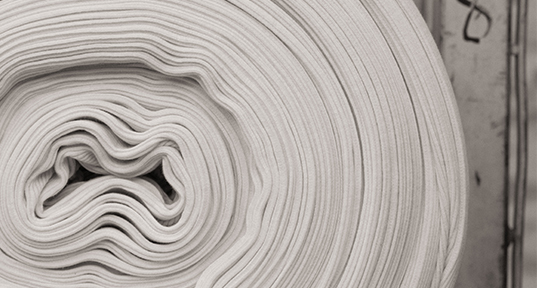Australian mandatory care labelling requires products to contain a care label to direct a customer on how to best use and launder a product. At a bare minimum care labelling helps preserve the life of a textile based product and helps customers make better choices about what products are right for them.
When working with deadstock fabric, there can be a gap in information from the fabric manufacturer and where you purchase it from, sometimes the fibre content might not even be known. In these cases, it may be necessary to perform a few simple wash tests at home to ensure proper labelling when you make a product. Check out our DIY Fabric Care Testing Guide below.

According to the ACCC, care labelling provides the public with enough information to:
- know how to care for clothing and textile products
- have prior knowledge of costs such as dry cleaning in the ongoing care of clothing and textile products
- understand how to clean clothing and textile products properly (e.g. cold hand wash only)
- maximise the useful life of clothing and textile products
- avoid damage such as dyes running (e.g. wash separately).
The mandatory standard requires that textile products including clothing, textiles, furnishing and suede skins, leathers and furs must have adequate care labelling instructions in English attached to the item.
The mandatory standard for care labelling for clothing and textiles applies to:
- clothing
- household textiles
- furnishings
- piece goods made from textiles
- plastic coated fabrics
- suede skins
- leathers
- furs
Get Started with DIY Fabric Care Testing
If you are a commercial brand with a large enough customer base, you might consider getting professional testing done on your deadstock fabrics. However, for small labels or home sewers, there are some common home tests you can perform yourself with just a few tools.
What you’ll need:
- 1 metre of fabric for testing
- Scissors
- Safety pin or permanent (laundry safe) marker
- Washing machine (domestic)
- Dryer (domestic)
- Tape measure
Shrink + Temperature Test
In this test you want to determine how much the fabric will shrink when washed. The process should be completed 3 times for best results.
- Cut 2 identical squares of fabric (ideally 50cm x 50cm each)
- Mark the top left corner of both samples with an X using permanent marker or use a vertical safety pin to ensure the fabric orientation can be determined again easily
- Machine wash ONE of the samples with other garments in like colours on the desired water temperature
- Allow swatch to dry naturally (do not iron or tumble dry to speed up the process)
- Once dry, measure the width and length change
- ie. if the new sample now measures 47.5cm wide x 48.5cm long, you’ll know there is 5% shrinkage width 3% shrinkage length
- Sometimes fabrics can grow, if this is the case, allow the fabric time to rest laid flat (about 1 hour after fully dried) before checking the length
- Compare the visible appearance of the washed sample to the unwashed sample
- Repeat the process 2 more times to check for further shrinkage
- You can keep the un-tested sample for comparative use in further testing including appearance, colour, pilling and shrinkage
- This test can be repeated with different water temperatures to determine the wash temperature tolerance
Wash Temperature Test
In this test you want to determine how hot the fabric can be washed, without visible change to the appearance of the material (including shrinkage, colour and surface changes). The process should be completed 6 times for best results.
- Cut 2 identical squares of fabric (ideally 50cm x 50cm) or complete this test after the shrink test and use the same sample that has already been washed.
- Mark the top left corner of both samples with an X using permanent marker or use a vertical safety pin to ensure the fabric orientation can be determined again easily
- Machine wash ONE of the samples with like colours on the desired water temperature
- Allow swatch to dry naturally (do not iron or tumble dry to speed up the process)
- Once dry, compare the visible appearance of the two samples noting any visible changes such as shrinkage, colouration, pilling or fibre fluffing
- Repeat the process 5 more times, if the fabric is greatly deteriorated, you may need to test again on a lower water temperature
- You can keep the un-tested sample for comparative use in further testing including appearance, colour, pilling and shrinkage
Tumble Dryer Shrink Test
In this test you want to determine how much a fabric will shrink or change in appearance when tumble dried. The process should be completed 6 times for best results.
- Cut 2 identical squares of fabric (ideally 50cm x 50cm) or complete this test after the shrink test and use the same sample that has already been washed.
- Mark the top left corner of both samples with permanent marker or use a safety pin
- Machine wash ONE of the samples with like colours on the desired water temperature
- Tumble dry the swatch with other items for the typical drying cycle
- Once dry, compare the size of the washed and tumble dried sample to the unwashed sample – measuring the width and length change
- ie. if the new sample now measures 45cm wide x 45cm long, you’ll know there is 10% shrinkage width 10% shrinkage length
- Repeat the process 5 more times to check for further shrinkage as well as change in colouration, pilling or fibre fluffing
- Keep the un-tested sample for comparative use in further testing including appearance, colour, pilling and shrinkage
DIY Fabric Care Testing by Circular Sourcing.
Common Care Instructions for fibres
Please note that care is not only based on fabrication but the kind of products made. For example a suit jacket might be made from machine washable linen, however with the addition of special fusings, buttons or linings, it may become dry clean only. This is a general guide for mono-fibres, which will also be affected by material structure (ie. knits, wovens, finishes). Likewise embellishments or prints may drastically change the care instructions. Please do research and due diligence before creating care instructions for labelling.
Silk
Hand wash on cold. Do not tumble dry. Warm iron.
Wool
Hand wash on cold with wool wash. Do not tumble dry. Warm iron.
Cotton
Machine wash up to 30 degrees, consider using a laundry bag for more intricate and delicate fabrics. Pull into shape while wet and hang to dry. Tumble dry low. Hot iron with steam.
Linen
Machine wash on cold. Do not tumble dry. Hot iron inside out with steam.
Hemp
Machine wash on cold. Do not tumble dry. Hot iron inside out with steam.
Viscose, Tencel or Modal
Machine wash on cold, consider using a laundry bag for more intricate and delicate fabrics. Do not tumble dry. Warm iron with steam.
Polyester
Machine wash on warm, consider using a laundry bag for more intricate and delicate fabrics. Tumble dry low. Warm iron.
Questions about Care? Get in touch with us.

